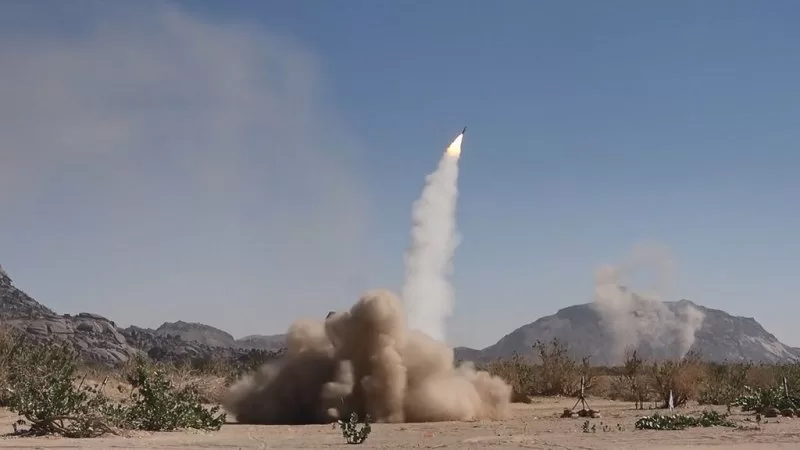A projectile is launched during a military exercise near the Yemen-Saudi Arabia border at Al-Baqaa area in the northern province of Saada, Yemen, in early January. U.S. Central Command said over Thursday it struck several Houthi targets in Yemen, including seven anti-ship cruise missiles. Photo by Houthis Media Center/EPA-EFE
Feb. 8 (UPI) — U.S. forces in the Red Sea conducted seven “self-defense” strikes targeting Iran-backed Houthi drone boats and missiles in Yemen Thursday, U.S. Central Command said, as the daily U.S. attacks in the Middle East threaten to further pull the United States deeper into the regional war.
The seven strikes were conducted between 5 a.m. and 9 p.m. local time, CENTCOM said. The targets were seven unmanned surface vessels and seven mobile anti-cruise ship missiles that U.S. military officials said were prepared to launch at vessels transiting the all-important trade route.
“CENTCOM identified these missiles and USVs in Houthi-controlled areas of Yemen and determined they presented an imminent threat to U.S. Navy ships and merchant vessels in the region,” it said in a statement. USV stands for unmanned surface vehicle.
“These actions will protect freedom of navigation and make international waters safer and more secure for U.S. Navy and merchant vessels.”
The United States has been conducting self-described self-defense strikes into Yemen where Houthi militants have been launching attacks on commercial and U.S. and British military vessels in the Red Sea and the Gulf of Aden since its first strike on Jan. 11.
The Iran proxy militia has been attacking ships since the war broke out between Israel and Hamas, another Iran-backed militant group, on Oct. 7, stating its demonstrating solidarity with the Palestinian people.
The Houthi attacks also occur as Iran proxy militias, emboldened by the war, increasingly attack U.S. military targets in the Middle East, most notably late last month when the Islamic Resistance in Iraq claimed responsibility for the three U.S. service members killed and some 40 others injured when it hit the Tower 22 base in Jordan.
The United States has responded with retaliatory attacks, including over the weekend in a drone strike in Baghdad that saw a leader of the Iran-backed Kataib Hezbollah terrorist organization killed.
The military activity has increased regional instability and fears of the United States becoming sucked further into the conflict that the Biden administration has repeatedly said it wants to see calmed. Its objective, administration officials have said, is de-escalation, and its strikes in Yemen are to deter the Houthis from further attacking ships while its targets are chosen to degrade military capabilities.
Pentagon spokesman Brig. Gen. Pat Ryder told reporters during a regular press conference Thursday that the U.S. strikes have “destroyed or degraded” more than 100 missiles and launchers, including anti-ship land attack and surface-to-air missiles, as well as communication capabilities, coastal radars, air surveillance capabilities, weapon storage facilities and aerial and sea drones.
He added that “it is a safe bet” to assume that Houthi militants have also been killed in the strikes.
“I will repeat again, that the U.S. does not want escalation and that these strikes are directly in response to the actions by the Iranian-backed Houthis,” he said. “Again, however, we will not hesitate to defend lives and the free flow of commerce in one of the world’s most vital waterways.”
The U.S. strikes seemingly have done little to dissuade the Houthis, who have continued their attacks.

